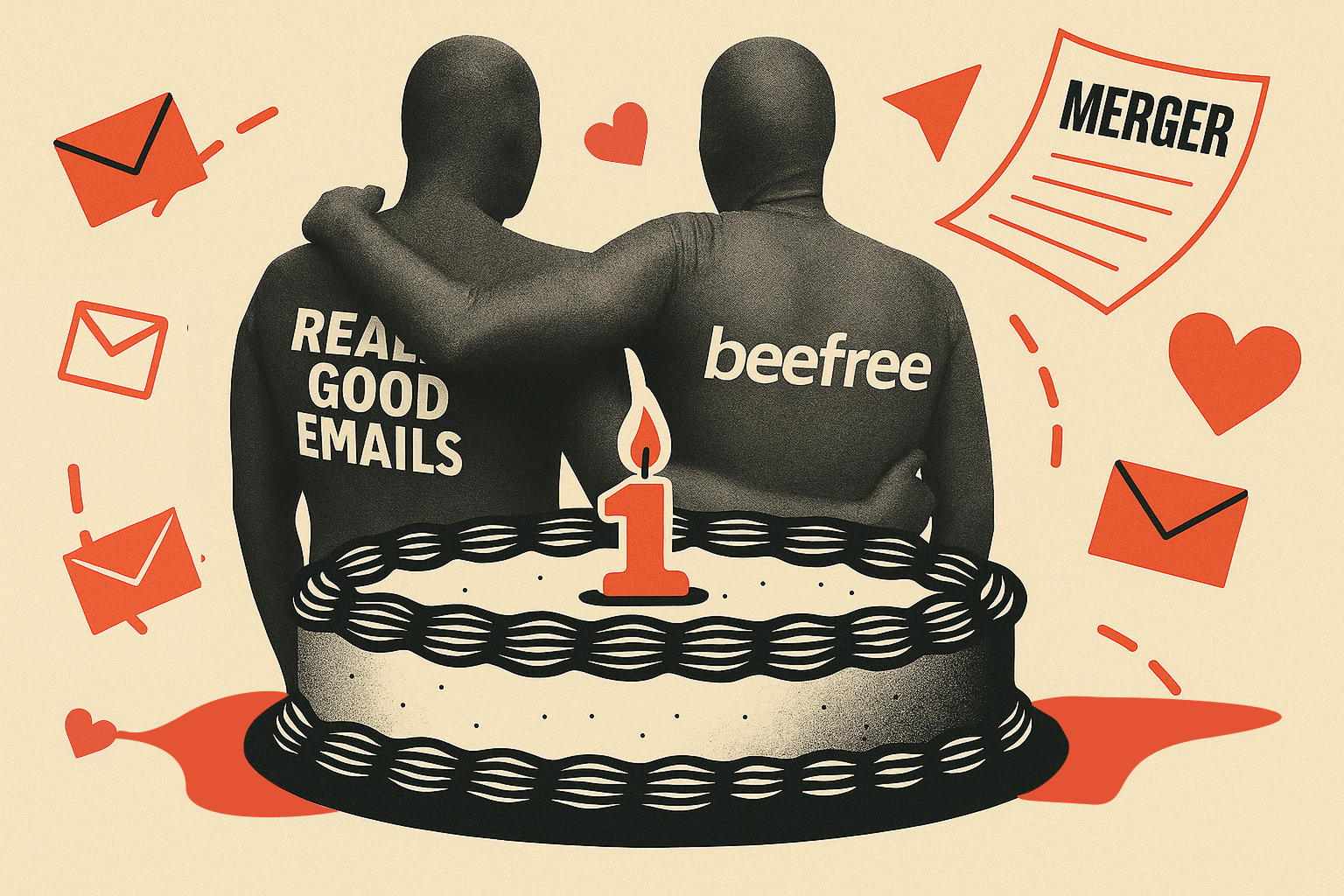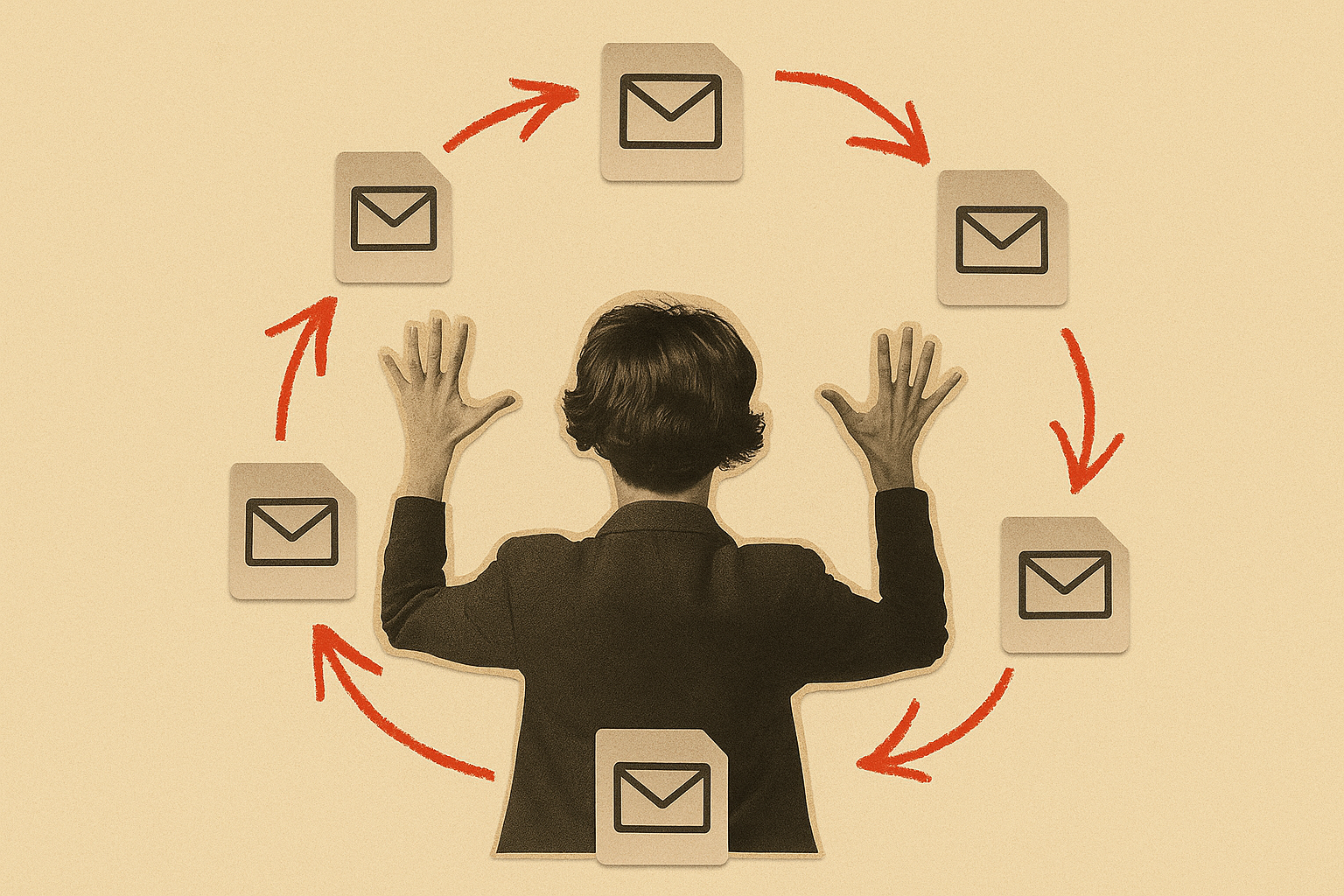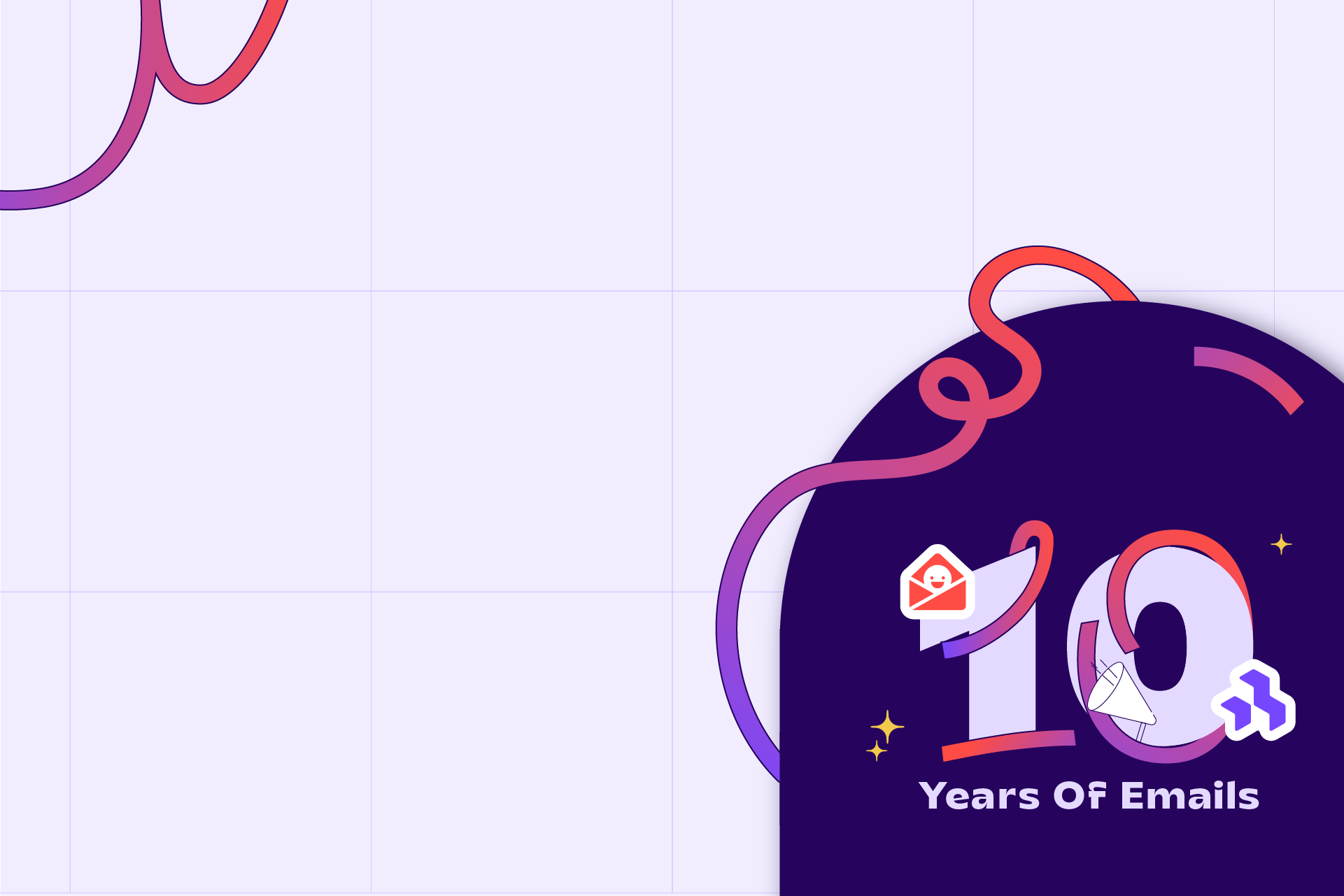Hello. Hello. I am so excited to be here. I can't even begin to find the right words for my level of excitement. I think I'm at an 11. Is anybody else at an 11? Okay, great. I have some things I must confess and a few things I need to get off my chest.
First of all, my name is Natalie Jackson. I'm the Director of Demand Generation at CBIZ. It is pronounced "CBIZ," not "C-B-I-Z" or anything else. We offer tax, accounting, benefits, and professional services. The point is, we offer more than 300 different services. And because we're B2B, as you can probably guess, they all want a newsletter, right? That’s what we do in B2B: we send newsletters. But I have some other confessions.
I've been in B2B email marketing for, I don't know, 14 or 15 years. The bread and butter of B2B email is the newsletter. That's what we do. We send newsletters. And everybody’s always like, “Hey, what’s going in the newsletter next month?” I’m tired. I’m tired of talking about newsletters. I love being in B2B, but sometimes we’re just not that innovative. And I confess: I’m hoping to evangelize. I hope many of you go home and say, “But what if it wasn’t a newsletter? What if we stopped sending newsletters and sent different kinds of emails?” That is my goal here today: to evangelize.
Now, I want to make one more confession before we get started. I am still sending newsletters, so this is a transformation. Please do not go to the CBIZ website, which is brand new and exciting; sign up for emails, and then say, “She’s lying to me. These are newsletters.” I know. I know. It takes time. If you take one thing away from today, give yourself some grace. It's hard to change the direction of a massive, moving ship while it’s crossing the ocean. But that doesn’t mean you shouldn’t try. That doesn’t mean you shouldn’t introduce new ideas or push to rethink how you're framing your email strategy. Just because we've always done it that way doesn’t mean that’s how we should keep doing it. Even though that feels like the mantra of every B2B company: “That's the way we've always done it.” Yeah, I know. Let's try something different. We're not always as exciting as B2C, or even nonprofit, but that doesn’t mean we shouldn’t try.
I want to take a second to tell you how I got here. Yes, those are my attempts at Lisa Frank animations. I couldn’t find the dolphins, though I did try. Look at this person. Look how hopeful she is, how joyful. I like to think of this as 2012, when I started at a new company as a content writer. They said, “You’re going to write all of our content.” I thought that sounded great.
Then, four weeks later, the person who had purchased Act-On in its very first iteration quit, and the person who ran the website also quit. The company came to me and said, “Do you know anything about HTML?” I was like, “Is that how it’s said?” And they told me, “You own email now.” I thought, “Oh my God. Okay. That sounds great.” Thus began my journey.
How many people here are in a similar situation? Somebody just said, “Hey, guess what? You own email now,” right? That’s almost all of us. So, that’s affirming. But it also means I’ve been sending newsletters since then, constantly thinking about content roundups. And because I am, at heart, a content person, it’s easy for me to fall into the mindset that everyone wants to see our content. So, let’s send more content. Think of this as 2019 Natalie. She’s peaceful, she’s smiling, her head is tilted. It’s almost like a glamour shot at the mall—minus the mall bangs, right?
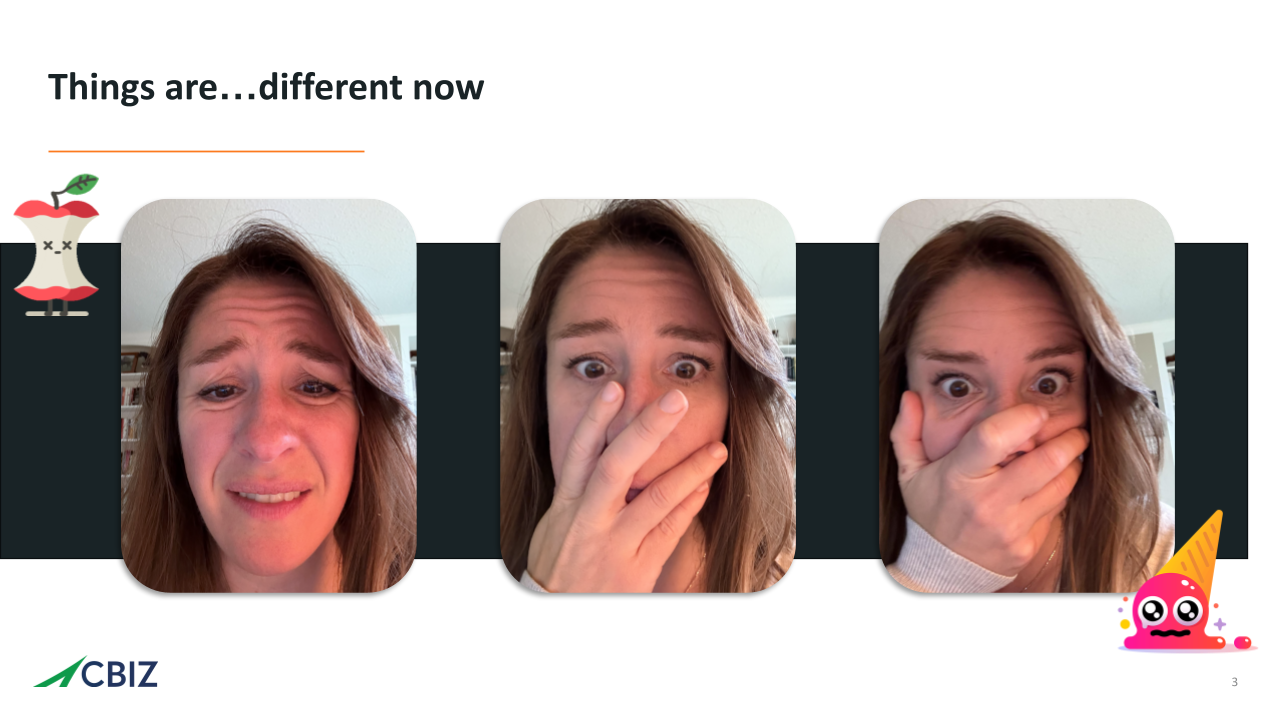
But now things are different. Natalie is gone. I don’t know where she went. This is 2020, Natalie. She’s looking at her inbox and realizing that the average attention span in 2012 was 75 seconds. Do you know what it is in 2023? Forty-seven seconds. That’s the average. I can barely hold a thought in my head anymore, because 2020 erased them all and then reframed them. We’ve come out of a massive pandemic amid global unrest. Attention spans are shorter. News is flying at us constantly. Every time you turn around, you’re like, “What happened? Wait, excuse me—what happened?” We’re also facing a workforce that went largely remote, and now we’re stuck in limbo. A lot of us are wondering, “Am I going to be remote tomorrow? Are we going back? Are we not going back? Are we hybrid? Where are we?”.
Our attention spans are short. Headlines are everywhere. And on top of that, this is my face when I look at my calendar in the morning. Now that we’re mostly virtual, with so many meetings online, we’re constantly digitally distracted. My day, maybe yours too, is a wall of team meetings. In between are tiny calendar blocks I carved out weeks in advance, just so I wouldn’t get booked over. That’s how I get five minutes to look at my email. I can see all the things I’ll have to do when I get out of this—another wall of meetings. I barely have time to process a thought, let alone read a newsletter. So, pop quiz: How many emails have you received since I started speaking? Has it been overwhelming?
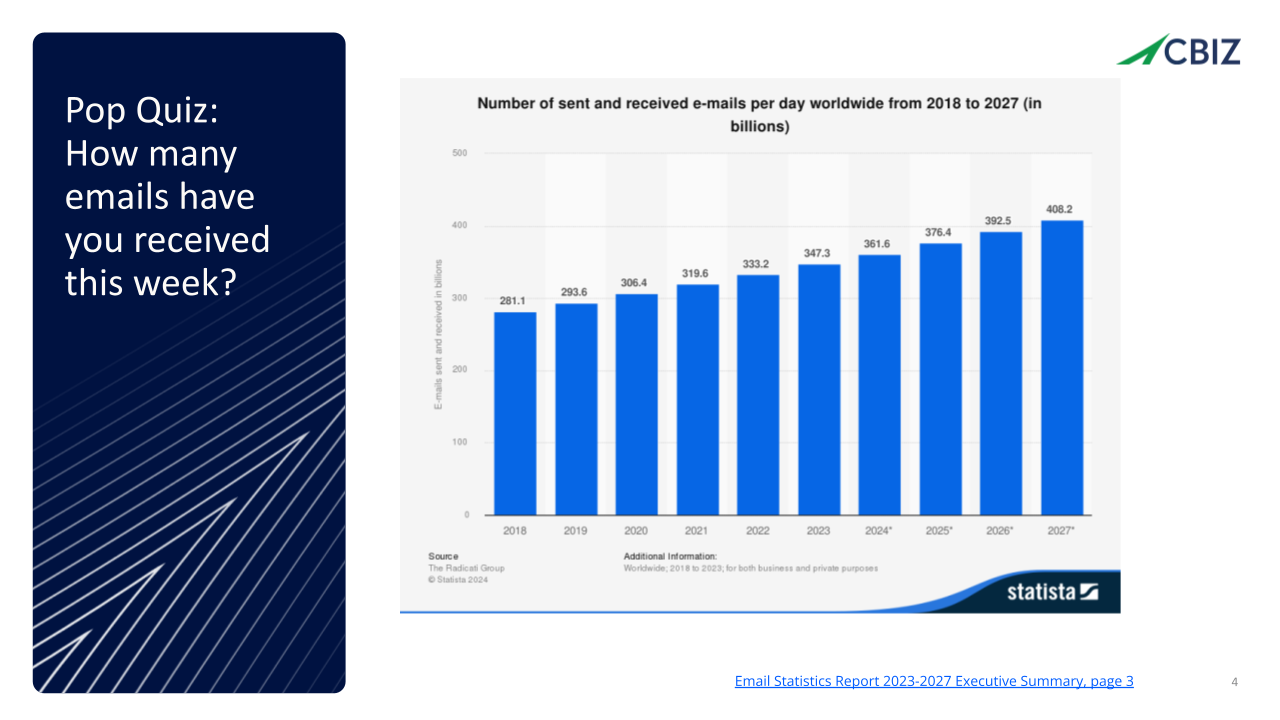
Do you look at that growing number in your inbox and think, “And that’s just my Outlook”? I get it in my Gmail too. And because I’m an email geek, I’m an avid email subscriber. I love your emails. But I get about 300 of them a day—in the promotions tab alone. That’s a lot. I can’t read them all. It’s really exhausting—and kind of stressful. I’m an achiever. It feels affirming to read through everything and respond to everyone. But I’ve had to face the reality that I just physically can’t do that every day.
So, I want to take a minute and say: That’s a lot. We have a lot coming at us. And one thing I’ve heard a lot lately, on email geek Slack channels, from peers, and in the broader email community, is: “Why are my clickthrough rates declining? Why aren’t my open rates what they used to be? Why aren’t we getting the same engagement from our emails?” I think it’s because we’re tired. We’re exhausted. And I don’t believe it’s all about strategy, though that plays a role. It’s about global exhaustion. So I started asking myself, “Why am I not engaging with the emails I used to love? Those emails that bright 2019, Natalie signed up for—why am I not engaging with them? What’s different? What’s changed? Why can’t I connect with those emails the way I did six years ago?” I had to step back.
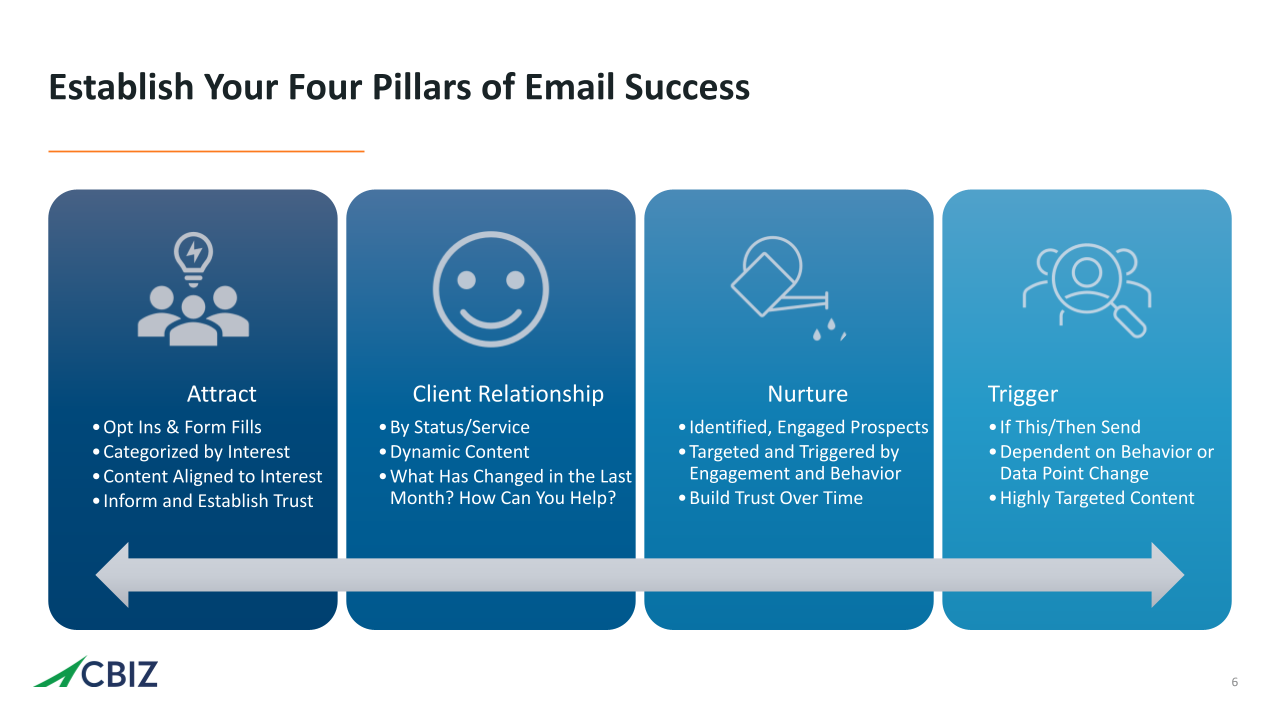
Maybe the long-form newsletter scroll doesn’t serve the way our brains have adapted to digital distraction since 2020. Most of our lives have moved online. I think it’s time for us, as email marketers, to ask: How can I better meet my digitally exhausted audience where they are right now? To do that, I recommend starting with your four pillars of email success. These will look different for each of you. This is what they look like to me, as a B2B marketer. Essentially, instead of starting with “Let’s send a newsletter,” start with: “What am I trying to accomplish with email?” If you can begin there, what is the purpose of email for me, what role is it playing—that becomes an excellent foundation. It helps you understand what kinds of emails you can send that aren’t newsletters, or maybe that function as pseudo-newsletters. As a B2B marketer, I need to attract new buyers.
I need to attract people into the nurture phase. Our sales cycle can be 18 months to five years, so I have to think about the long game. Email is perfect for that. But first, I have to get you in there, right? First, I have to get you to tell me who you are. It’s not just me signing you up because I like your email domain, which happens in B2B, but we shouldn't do that. This is about client relationships. I want to keep these people. This is a retention play. I want to make sure I have engaging content that builds credibility, that lets people see us as leaders in this space, so they don’t leave us for someone else.
I want them to know that we have the answers, no matter what’s happening. Whether it’s in the headlines, in the news, or anywhere else, we have the answers they need. I need to continue to establish that. I need to nurture people. These are long-game prospects, and I need to make sure I’m consistently building credibility and trust. When they’re ready to buy, I want them to think of me first. I want them to be willing to fill out the contact us form. Lastly, I need to pay attention to triggering events. If I know something important is happening at your company, in your life, in the news, or in your industry, and I have a solution for that, I want to make sure I get that solution to you. I want to help you solve the problem I know you’re facing. To do that, I need to free up calendar space from all those newsletters. Because if I stack these four types of emails on top of a newsletter strategy for 300 services, that’s way too much email. That’s where the exhaustion comes from.
You have to take a step back and ask, what if we set the idea of a newsletter aside and first thought about what we’re trying to accomplish with email? Time is critical in email. This is actually my biggest frustration with newsletters right now: they’re scheduled. Raise your hand if your newsletter is scheduled to go out on the same day every week or month. Right? You get pushback from leadership. They’ll say, “Our newsletter goes out at 3 p.m. on Wednesday.” But we need to ask, why? Why 3 p.m. on Wednesday? What does that even mean? To me, email is a complex mix of timing, audience, and interest. That’s what I respond to when I look at my inbox. I want to show you what my Gmail tab looks like. As I scroll through, some emails stand out more than others.
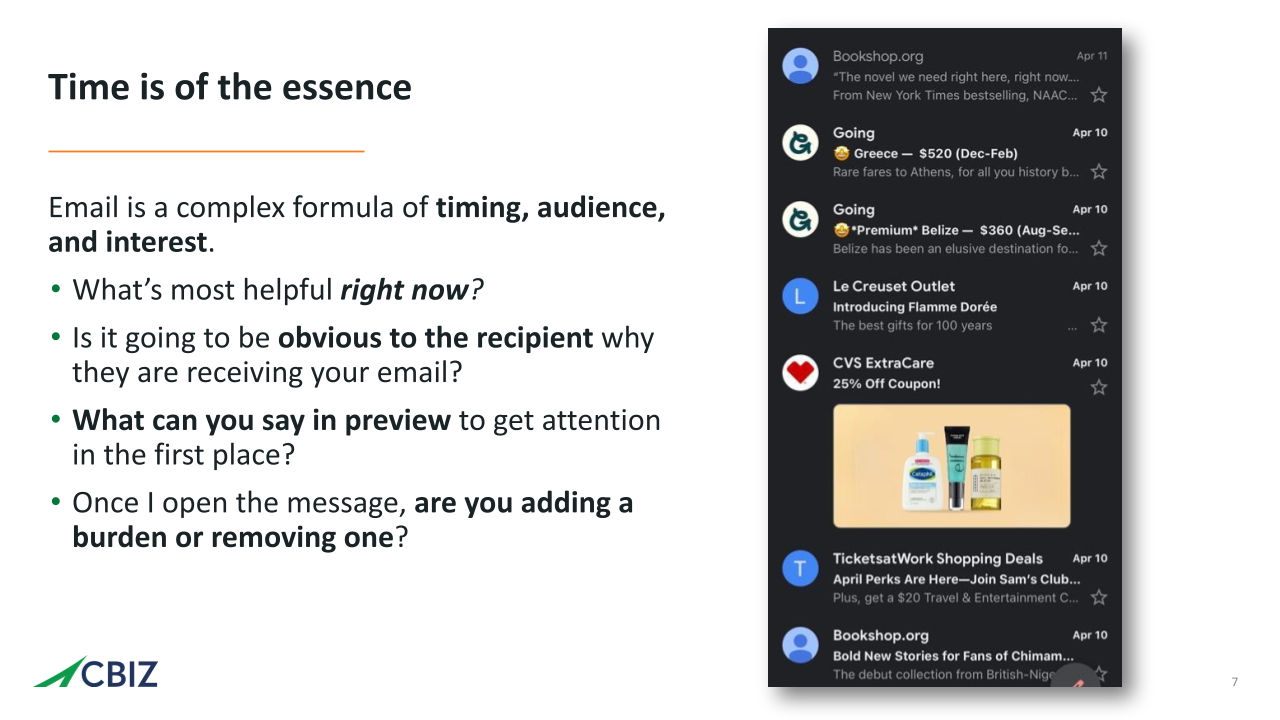
You’ve heard me talk about how much I love Justin’s emails. Every time they send those “going” emails, I’m hooked. If you tell me “five $20 getaways,” I’m in. That subject line tells me it’s a short-term offer, shows the price, and gets straight to the point. You’re not tricking me or trying to manipulate me into opening it. I don’t like being tricked by subject lines. When I open it and realize it was misleading, it feels bad. It means. It’s just not a good experience. Then there are other emails, like “25 percent off,” that show an image I can’t even interpret. I don’t know what’s being offered. I don’t want any of it. That makes it easy for me to delete it during my first pass through my inbox. So I encourage you to focus on subject lines. If you can keep them clear and concise, and if you can hit that intersection of timing, audience, and interest, your email has a better shot at surviving the first wave of mass deletion.
I’ve entered my bulk delete phase, and I’m sorry. That’s part of the confessional. I use the subject line to ask myself, “Do I want to come back to this?” So I take a first pass. I delete a bunch of stuff. But then I might say, “Oh, Greece. I hope Greece is still okay.” Then I come back and click through the ones that seem timely and relevant during the five minutes I have to read my email. Once I open the email, I want to know why it matters to me right now. This is where tricks don’t help. If you trick me into opening your email and it isn’t great, I’m disappointed. I might need to do a second slide about that next time. Let’s make sure your emails are rad. When I say “rad,” it’s a little like saying “brave.” It’s the next level. I want your email to be:
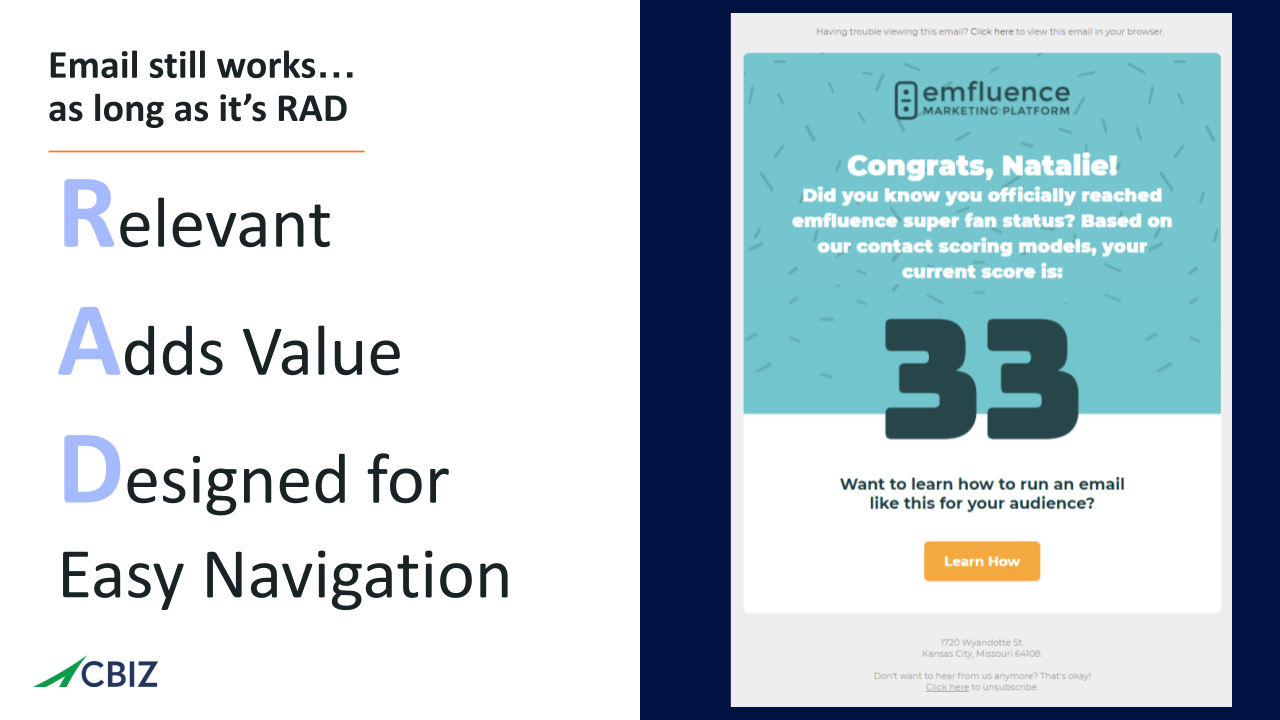
I want them to be relevant. Does it matter to me? Is it responsive to me? Is it adding value to my day? Is there something in it that makes me think, “Yes, I’m so glad I opened this”? Because if I read it and don’t get value, I’m not going to be happy. And is it designed for easy navigation? Is it clear what you want me to do? Is it obvious what happens when I take that action? Will it be clear what the whole point of the email is? Here’s an example I created when I was at Influence, and I love it because I think it’s a great fit for the audience. It probably wouldn’t work unless you were in a marketing automation company. What I wanted to do was trigger an email to everyone in the nurture funnel once they reached a certain contact threshold. The message said something like, “Hey, look at your contact score,” and it was all personalized. “Your contact score is 33.”
If you wanted to learn more about how to use a contact score-based trigger in your automation program, it would link to a resource explaining what to think about, what to consider, and how you could use that score to become a better email marketer. It was fun, a little tongue-in-cheek. It wouldn’t make sense outside of an email marketer audience, but it worked well because we understood the audience, the timing, and the purpose behind the message.
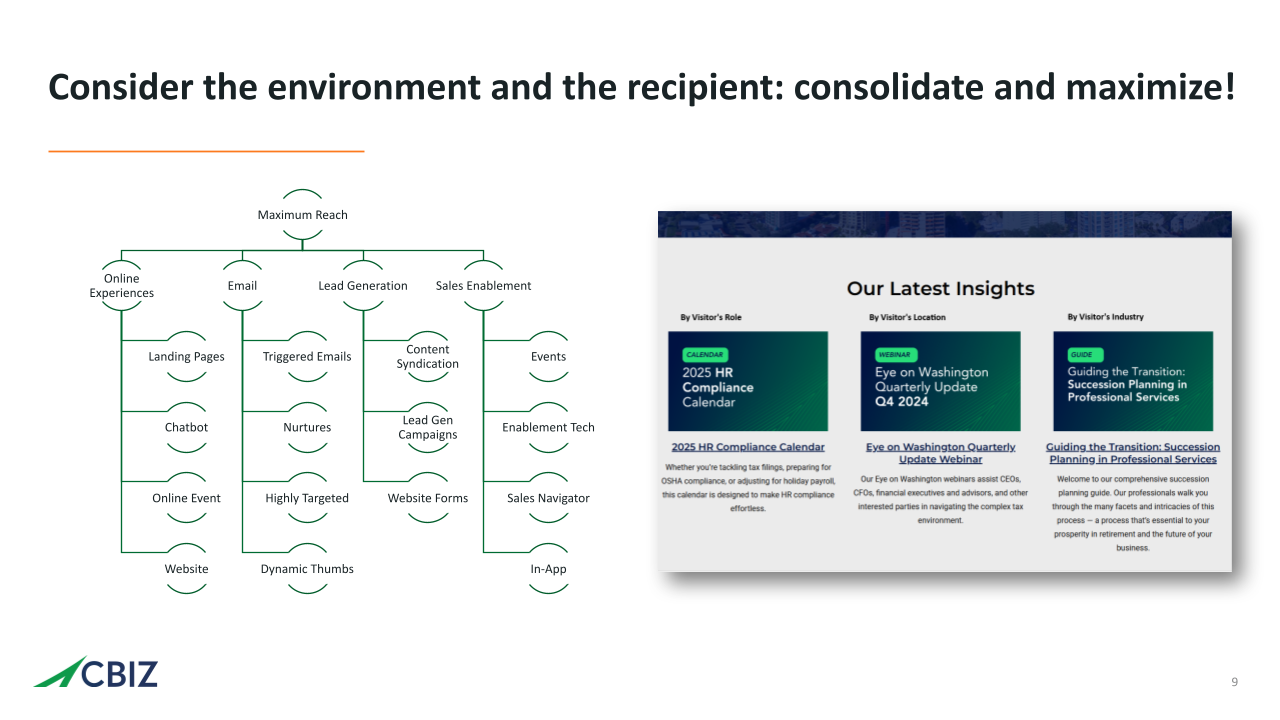
Another thing I want you to think about is something kind of bold to say in a room full of email marketers: email is not your only channel. You may have excellent content, but don’t rely only on email to distribute it. Look at other places where you can co-promote the content you're putting in your email. That might make more sense for your buyer or your audience.
For example, if your goal is maximum content reach, have you considered using dynamic content in your emails so you can send fewer messages overall, but surface the most relevant items for each recipient? Have you considered using dynamic online experiences? Are your landing pages dynamic? Is your website dynamic? Does your chatbot serve dynamic content? We have so much data as email marketers. Have you talked with your other automation partners to ask, “Do we have opportunities to co-promote this content in a way that benefits both teams?”
You can do a lot of this even in a gated format. For instance, your chatbot could require an email address to access a resource. Then, after the user downloads it, you can ask, “Can I send you some emails? Do you want to subscribe? Are you interested in more like this?” You can still be helpful and nurturing without crossing into spam territory, and you can extend that strategy across all digital channels. Sales enablement technologies are also great places to co-promote. And here’s a bit of a soapbox moment: email marketers should own sales enablement technologies.
We can use those tools to pull outbound sellers into our email strategy and ask, “Can you help bring people into the nurture funnel?” No, I will not add your prospect list to my newsletter. But I will give you a link to encourage those prospects to download content. That puts them into the nurture flow and helps build our subscriber base.
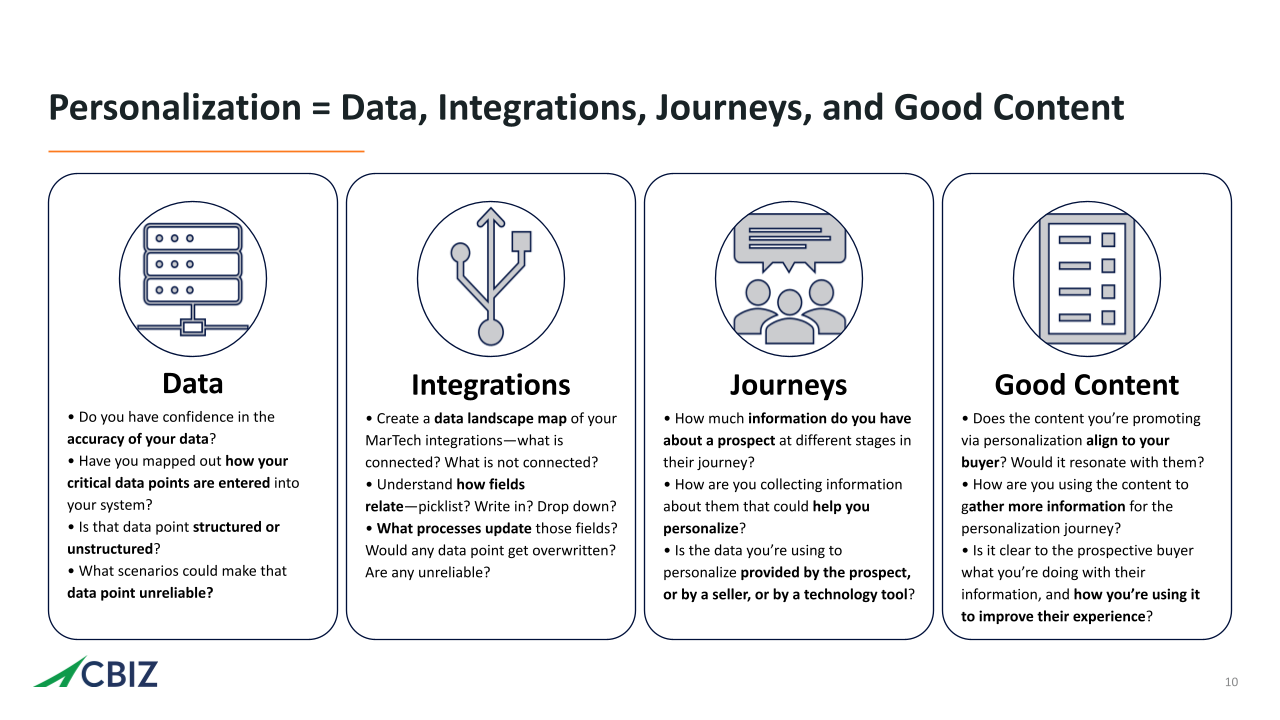
Personalization, of course, requires a deep understanding of your data. And I promise I won’t read this entire slide, so feel free to take a photo or review it later. When we talk about personalization—and I know many of us have talked about this throughout the week—it starts with data hygiene and control.
Do you trust your data? Is it accurate, or is it going to throw in the wrong values? My favorite example is when someone puts something like “Mr. John Whatshisname” into a CRM field. And you’re left with “Dear Mr. John Whatshisname.” That’s not a great email experience. You need to review your data sets and understand how those fields are being populated. Are they trustworthy? Do you know where that data is coming from before you start building a strategy around it?
If not, things can go wrong quickly. Integrations are a big part of that. How is your data being updated? Is it maintained regularly? If you want to use something like a date-based trigger, you need to understand how often that field is updated and from what source. Is that data syncing into your marketing automation platform?
And then, how much do you know about the customer journey? Where are your contacts in the funnel? How engaged are they? How interested? That data might not live in your email platform. It might live somewhere else. Can you integrate it back into your email program? Even if it means creating custom fields, you should be able to see how engaged someone is—or isn’t. The way you treat a brand-new subscriber should be very different from how you treat someone who’s been engaging with you for five or six years. So can you personalize based on that data point, too?
And then lastly, this is so important. Again, content marketer at heart here. Is your content good? Please do not send out terrible content and then wonder why nobody downloaded the checklist. It probably wasn’t great. So make sure your content is relevant, interesting, and something people actually want to download in the first place. Also, do not forget your platforms. I'm not going to shame anyone here, but come on. This is my Outlook inbox, and it hurts my heart. I can’t see anything. I’m sure it looks great in Gmail, but in Outlook, it’s unreadable. So think about your platforms when you're thinking about your audience.
As a B2B marketer, I have to have this conversation with every person who works on emails with me. I always have to ask, “Did you run that through Litmus or Email on Acid or any tool to check how that button renders?” Oh, you set it at 100 percent width? That’s going to be a problem. You have to remember that certain email types look terrible in some clients. A lot of them are going to look bad in Outlook. That’s just the truth. Now that we’ve set the foundation, I want to give you some examples of my favorite emails. These are the ones I still read. I want to show what they’re doing that helps us move forward beyond the typical newsletter.
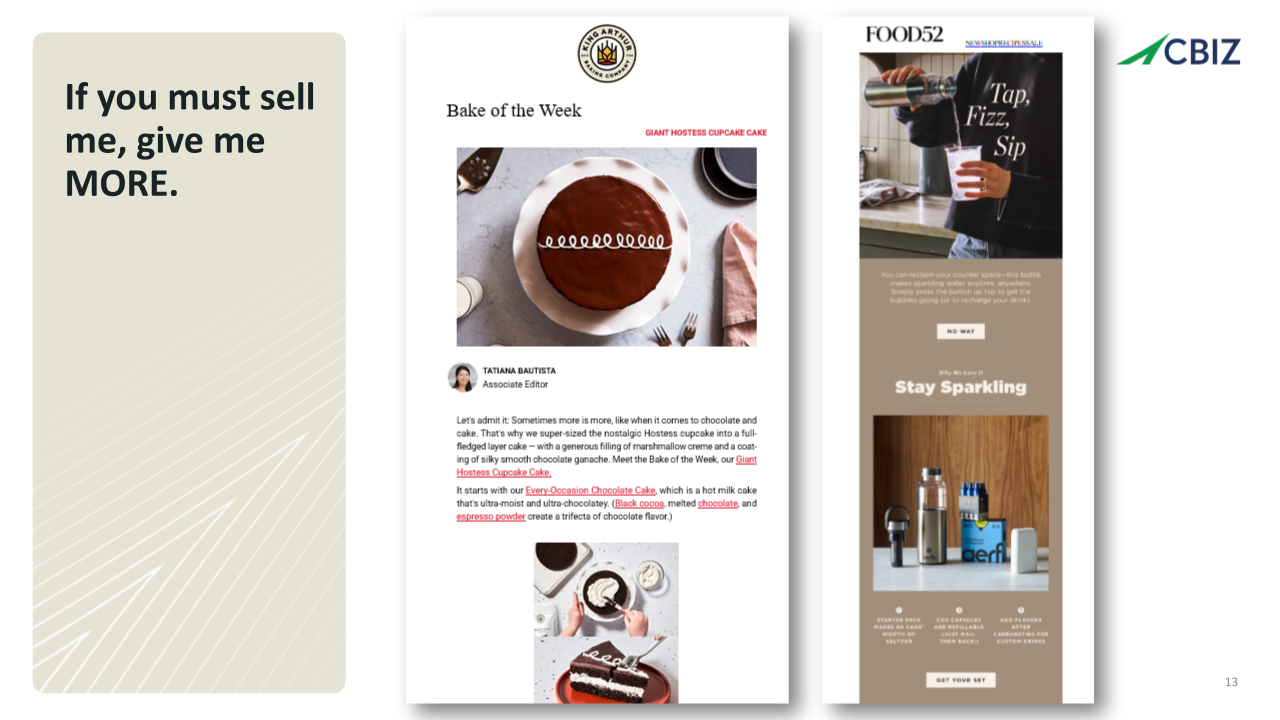
Let’s start with e-commerce. If you must sell to me, please give me something more than a “buy now.” I get so many of these. I don’t know why sweater companies think I’m buying a sweater every week. I don’t have that kind of money. So what else can you give me to keep me engaged as a subscriber? Not just discounts. Even 25 percent off isn’t enough to convince me to buy something every week. Can you help me style something? Can you help me make something? Can you inspire me?
King Arthur Baking Company is a great example. If you’re not on their list, sign up. They send recipes. One of their subject lines was “Giant Hostess Cake.” I opened it immediately. And inside, they show you how to make it. It’s super easy. They give you the recipe and say, “Here are the ingredients,” which, of course, you can buy from them. It’s a soft sell. It’s about giving value first, offering inspiration, and then tying in the products naturally.
Food52 does this really well too. They’re selling products, which is harder than selling ingredients, but they’re thoughtful about it. They usually pick one product and tell you everything about it. You get a full breakdown—features, people who made it, ways to use it. Even if I don’t need a martini mixer, I start thinking I do. They dive deep into one product rather than showing me everything that’s on sale this week.
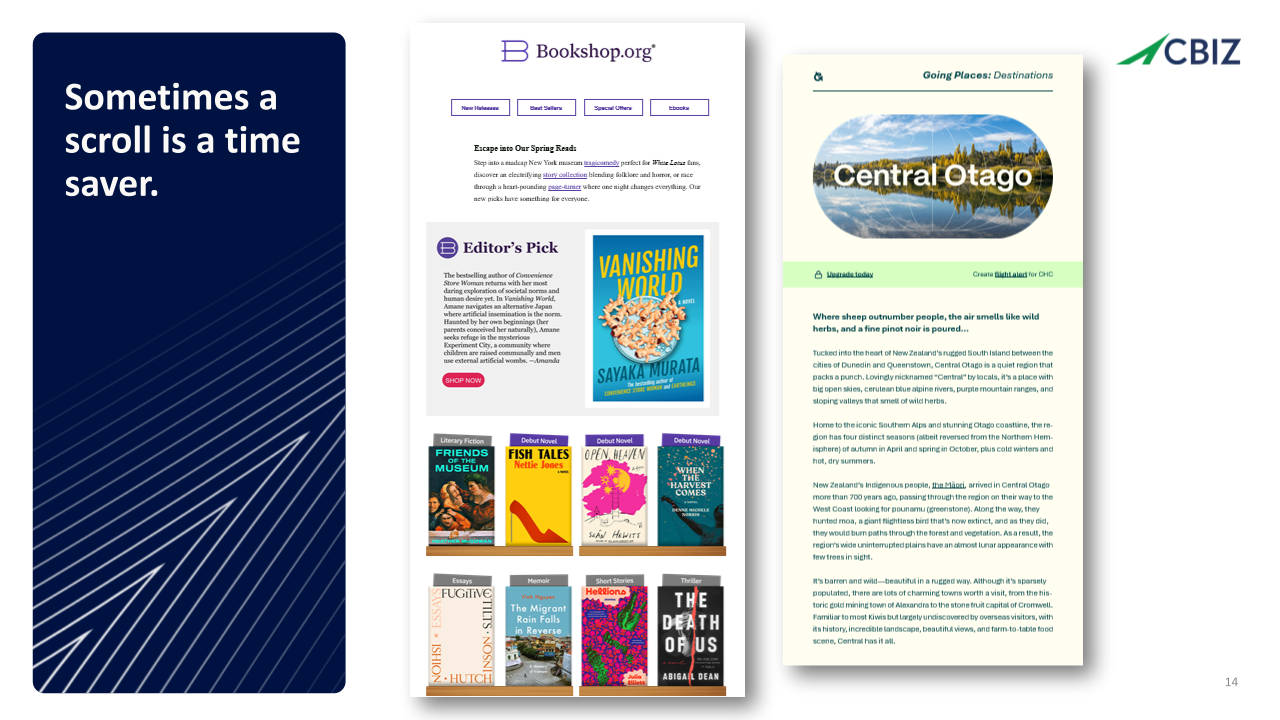
That said, sometimes a scroll is a time-saver. One I really like is from Bookshop.org. Anyone else subscribe? I love it because it helps me update my to-be-read list. I keep a long one. If you do too, let’s talk. Their email makes it easy to see what’s new, what authors are featured, and which books I want to look into. They even break it out by genre, which I appreciate because I don’t want to scroll through genres I’m not interested in. It’s quick, efficient, and helpful. I don’t always click on the email, but I get value from it just by scrolling. Then there’s Going—formerly Scott’s Cheap Flights. I gush about these emails. I recommend everyone sign up. I’ll give you a referral link if you want.
Their emails highlight destinations I never would have considered and include long-form narratives about the niche experiences you can have there. It’s not a list of cheap flights. It’s a story. You won’t find these tips on TripAdvisor. It’s not a hard sell. But there is a call to action. They say, “Download the app” or “Sign up for the paid plan.” It’s soft, but it’s there. The story is the main value. The CTA supports it without being the focus. I open every email they send. I promise they won’t unsubscribe me because I’m highly engaged.
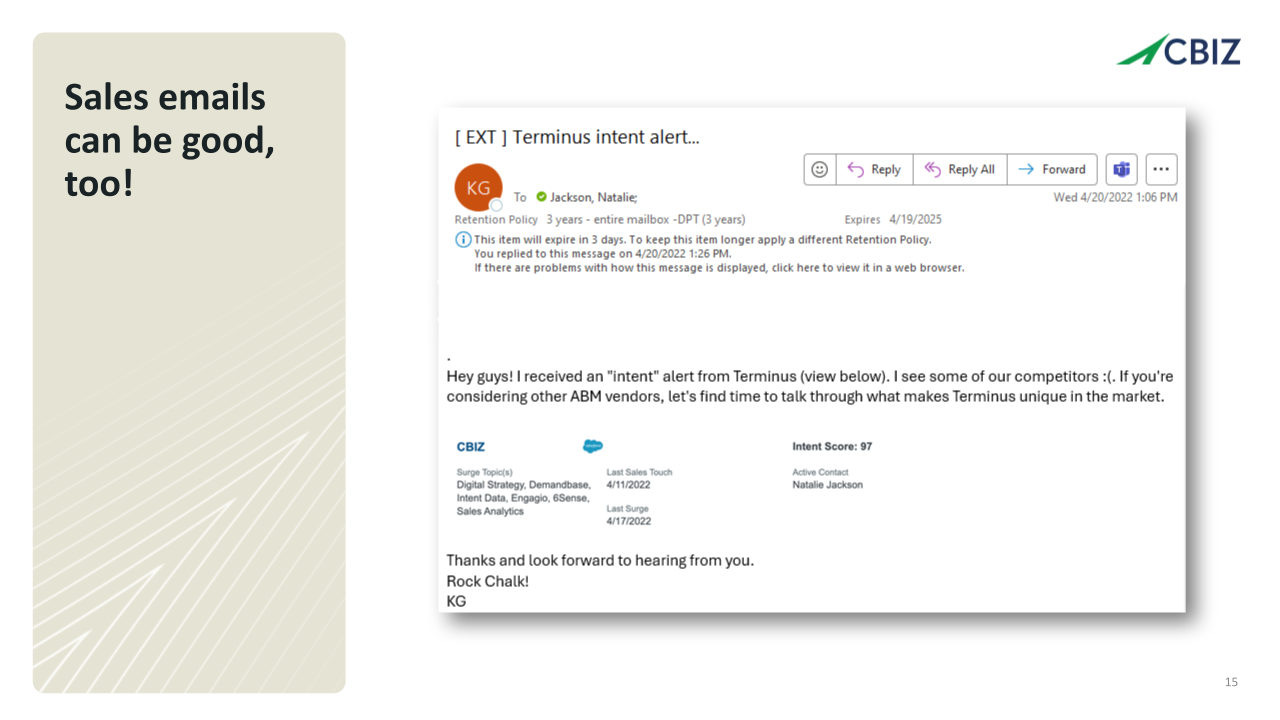
Sales emails—yes, sales emails—can be good too. I know someone out there is clutching their pearls, but hear me out. You can be involved in outbound sales emails and help make them better. It’s still an email channel. I got one when I was researching account-based marketing software. We were talking to one provider, but I started looking at others. Then I got an email from our contact saying, “I can tell you’re looking at other ABM tools, and I want to know why.”
I felt like I got caught cheating. I was apologetic. “I’m sorry. I should’ve told you. I was just window shopping.” It was relevant. It felt personal. That wouldn’t work if you were selling accounting software—it would feel invasive. But if you understand your audience, you can send something that feels human, not creepy or cold. So I saved that email. And yes, Rock Chalk Jayhawk. No other Jayhawks in the room? Okay, we’re moving on. I’m still recovering from the tournament.
Next: get to the point. Sometimes content marketers overdo it. We get so caught up in the narrative and story. And while there’s a time for that, there’s also a time to say just one thing and move on. You don’t always need a clickthrough. Sometimes you just need to be helpful. That alone can build the relationship.
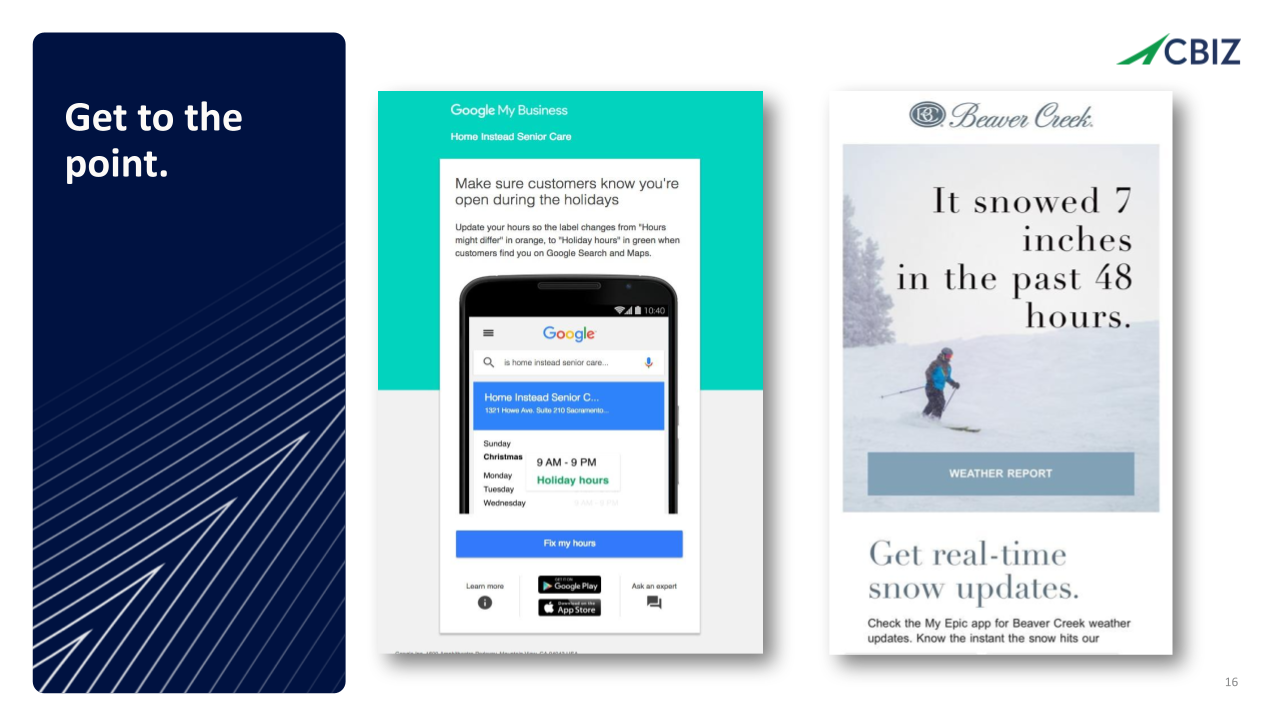
First, Google My Business. This one is quick and simple. It says, “Don’t forget to set your holiday hours.” That’s important. You don’t want customers showing up to your business when no one is there. That’s a bad experience. So they’re offering a helpful reminder. It’s not focused on ROI or conversions. It’s just good relationship-building.
Second, Beaver Creek. Anyone else here ski? I do, and I love it. Their email said, “It snowed seven inches in the past 48 hours.” That’s all I needed to hear. I didn’t need a weather report. I didn’t need more context. I just wanted to grab my skis and go. It was the perfect message. No fluff. Just the right information at the right time.
That’s the kind of message that gets me to take action without even thinking. No extra steps, no click required. Just a fast, useful update that fits my interests.
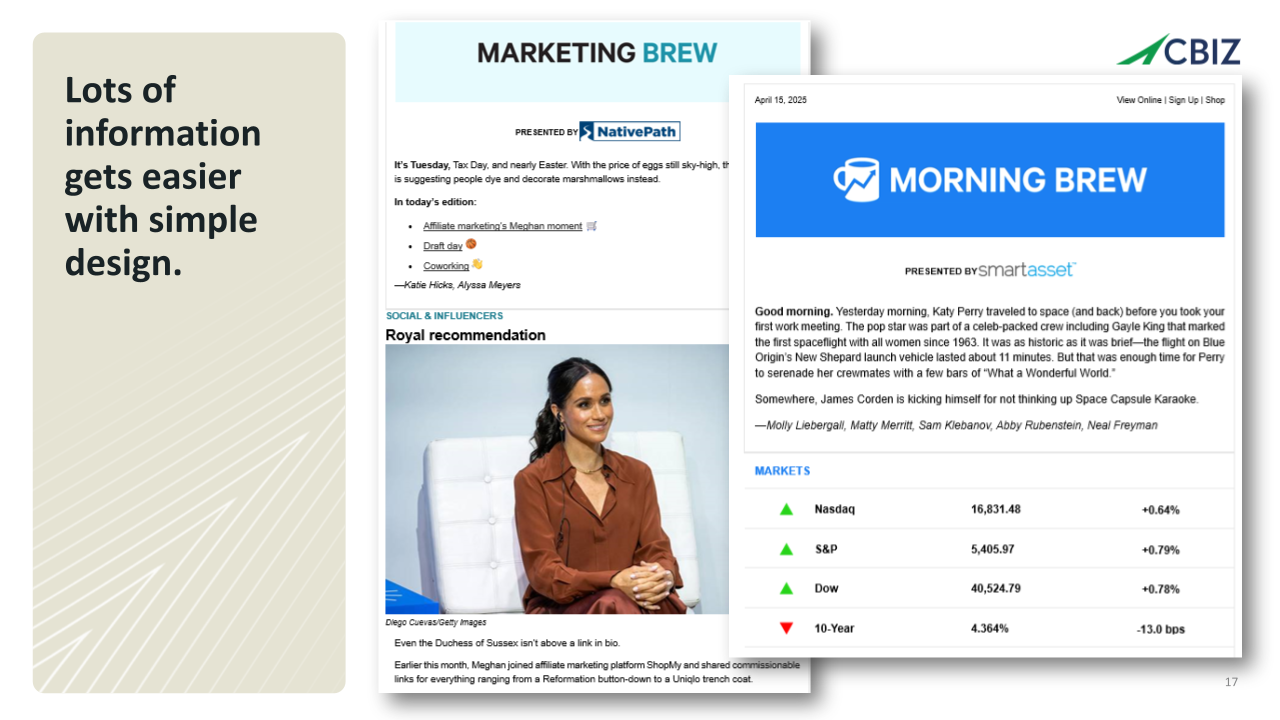
So I had to ask, “Why did she like this so much? What made her feel it was worth sharing?” And the answer made total sense. Her role is externally focused. She spends time pitching speakers, working with media, placing people in interviews. This email was packed with relevant information she needs to do her job. For her, it was incredibly helpful. For me, it wasn’t. I didn’t have the attention span for it. But that’s the point. You have to know your audience.
You have to ask, “What am I doing for this person today?” As email marketers, we should be in service to our recipients. Can I save them time? Can I save them a click? Can I help them get the information they need quickly and easily? That is the unique value of email. No other channel can deliver like that. I can tell someone what they need to know right now. But only if I can move beyond the idea that my email has to go out at three o’clock every Wednesday and that every message must be measured by how many people clicked.
Sometimes it’s about being the fastest, most helpful channel in the marketing mix. And if we lean into that, we can build stronger relationships, get closer to the customer, and earn the trust that we as email marketers should always be aiming for.
All right. Thank you. I hope you're ready to end the newsletter.
